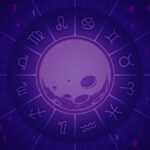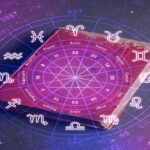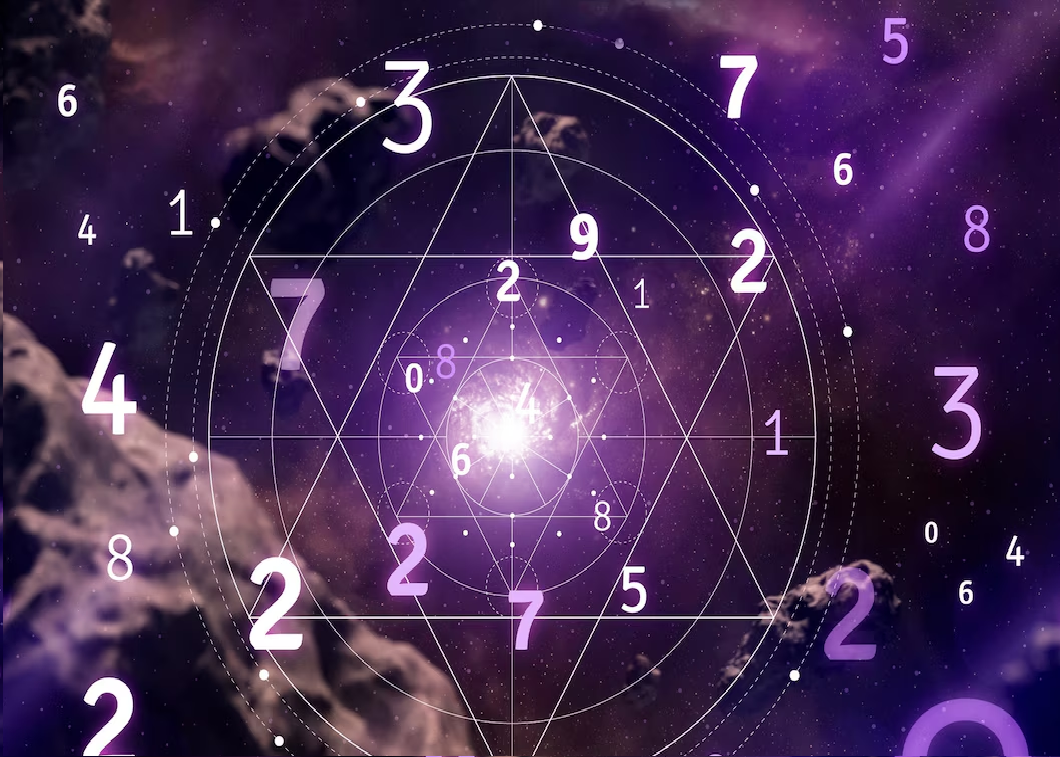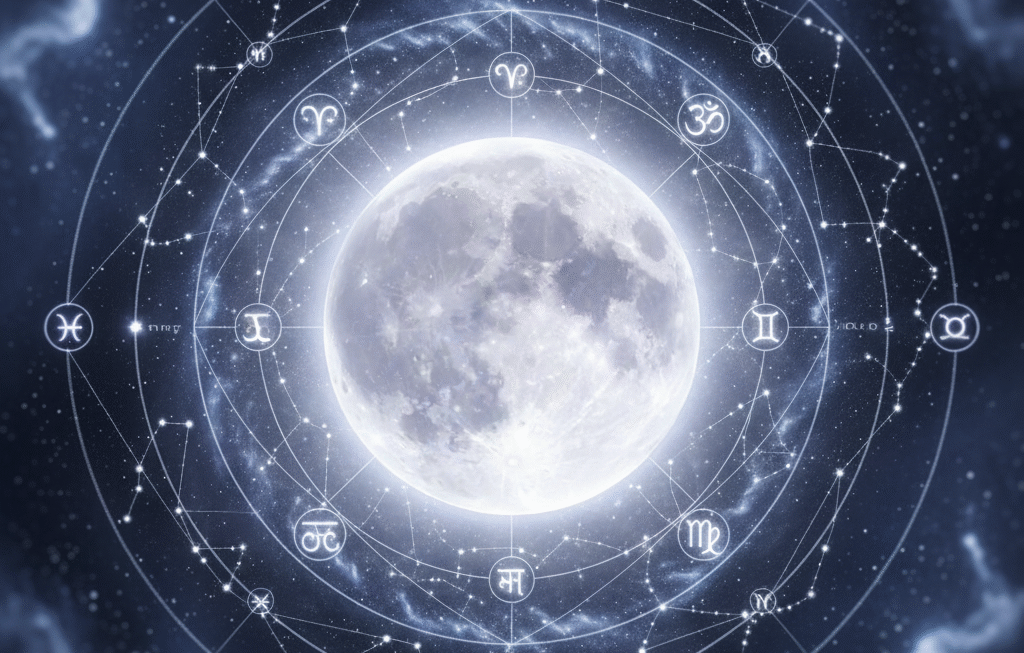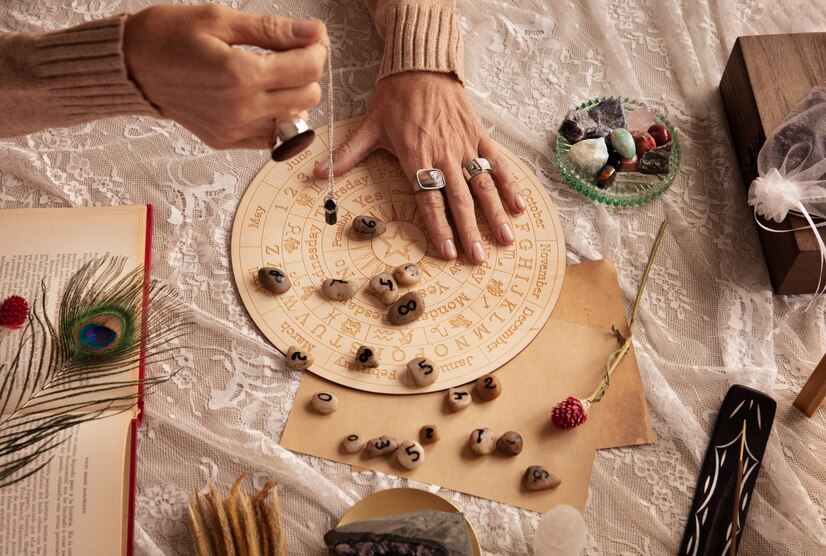This analysis explores Gochar, the study of planetary transits in Jyotish (Vedic Astrology). We examine Understanding Transits (Gochar) from traditional, contemporary, student, and practical perspectives. While Dashas (planetary periods) indicate the timing of karmic potential unfolding, Gochar reveals the current planetary movements and how they interact with the Natal Chart Positions, acting as triggers for events and influencing daily experiences. Key transits, especially of slow-moving planets like Shani (Saturn), Guru (Jupiter), Rahu, and Ketu, are crucial for Predictive Astrology Techniques when synthesized with Dasha periods and natal chart strength.
LENS 1: Traditional Foundation (The Classical Jyotishi’s View)
Key Findings: Traditional Jyotish views Gochar (transit) analysis as a vital, though secondary, predictive tool complementing the primary Dasha system. The current positions of Grahas are compared against the natal chart, particularly the position of the natal Chandra (Moon), but also the Lagna (Ascendant) and sometimes Surya (Sun). Transits through favourable or unfavourable houses from these points, and aspects (Drishti) cast by transiting planets onto natal planets/houses, indicate temporary good or bad results.
Detailed Analysis:
Classical texts provide detailed results for each Graha transiting through the 12 houses counted from the natal Chandra (Chandrashtama – Moon’s transit through the 8th from itself is particularly sensitive). Slow-moving malefics like Shani transiting key points cause significant concern (e.g., Sade Sati, Dhaiya – Saturn’s transit over 4th/8th from Moon). Benefic transits (like Guru over natal Moon or key houses) promise temporary relief or opportunity. The strength of the transiting planet (e.g., exalted, retrograde) and the natal strength of the point being transited modify the outcome. Ashtakavarga is a complex traditional system used to quantify the auspiciousness of transits through specific degrees based on all planetary positions.
- Technique Deep Dive: Ashtakavarga System: This intricate system assigns benefic points (bindus) contributed by each planet relative to others and the Lagna for each sign. Summing these points creates a score for each sign (Sarvashtakavarga). Planets transiting signs with high scores tend to give better results; those transiting signs with low scores give poor results, regardless of other factors. It refines Gochar analysis significantly.
- Expert Insight (Traditional Source): “The results indicated by the Dasha lords come to pass when the Grahas in Gochar transit favorable positions relative to the natal chart and possess strength, confirming the natal promise.” – Principle reflecting classical Jyotish integration of Dasha and Gochar.
- Hidden Wisdom: Vedha & Viparita Vedha: Specific transit positions that obstruct or neutralize the good or bad effects of another transit position. Analyzing these adds another layer of complexity and accuracy to Gochar interpretation beyond simple house transit results.
- Astrological Framework Map Suggestion: Diagram showing the natal chart (focus on Moon/Lagna) with arrows indicating transiting planets moving through the houses counted from the Moon/Lagna. Highlight Sade Sati calculation. Briefly illustrate Ashtakavarga scores per sign.
- Critical Considerations: Relying solely on Gochar results from the Moon (as often simplified) without considering the Lagna, Dasha period, and overall natal strength leads to inaccurate predictions. Transits trigger natal potential; they don’t create results out of thin air.
LENS 2: Contemporary Interpretation Framework (The Modern Jyotishi’s Approach)
Key Findings: Contemporary Jyotish utilizes Gochar analysis extensively, often integrating it closely with Dasha interpretation to understand current life themes, psychological shifts, and timing of events. Transits are seen as activating specific potentials and lessons indicated by the natal chart and current Dasha lords. There’s often more emphasis on transits relative to the Lagna alongside the Chandra Lagna.
Detailed Analysis:
Modern practitioners track the transits of slow-moving planets (Shani, Guru, Rahu/Ketu) for major life trends and psychological phases (e.g., Saturn return, Jupiter return). Transits of faster planets (Surya, Chandra, Budha, Shukra, Mangal) are used for timing shorter-term events or influencing daily mood/focus. The interaction between transiting planets and natal planets (via conjunction or aspect/Drishti) is closely examined for specific triggers related to Natal Chart Positions. Gochar is used to understand the current flavour of the Dasha experience.
- Technique Deep Dive: Dasha-Transit Synergy: The most potent predictions often arise when the Dasha/Antardasha lords are simultaneously activated by favourable or challenging transits involving those same planets or the houses they rule/occupy natally. For example, if running Venus Dasha/Mars Antardasha, a transit of Mars aspecting natal Venus could trigger relationship events indicated by their natal connection.
- Expert Insight (Modern Jyotishi): “Dashas show the karmic chapter you’re in; Gochar shows the weather you’re experiencing day-to-day within that chapter. When the Dasha promise aligns with a triggering transit, events manifest.” – Contemporary Jyotish Practitioner.
- Alternative Approaches: Some integrate psychological transit interpretations (e.g., Saturn transit bringing themes of responsibility/fear related to the house it transits). Using transits in Varga charts (divisional charts) for highly specific timing is an advanced technique.
- Astrological Framework Map Suggestion: A visual showing Dasha periods as large blocks of time, with smaller Gochar cycles (like Saturn’s or Jupiter’s) moving through the natal chart houses within those blocks, illustrating the interaction.
- Critical Considerations: Focusing too much on minor daily transits without considering the larger Dasha context can lead to ‘astrological weather reporting’ rather than meaningful insight. The natal chart’s strength always overrides or modifies transit effects.
LENS 3: Learning Path Analysis (The Student’s Perspective)
Key Findings: Students must learn to synthesize Gochar with Dasha and natal chart analysis. Key steps include understanding how to read transits from the Moon and Lagna, memorizing core transit results (esp. for Shani, Guru, Rahu/Ketu), and grasping the concept of transits as triggers rather than standalone predictors. Learning Ashtakavarga is an advanced step.
Detailed Analysis:
Students learn to track current planetary positions against their own natal chart. They memorize the general effects of planets transiting houses from the Moon (e.g., Guru favourable in 2, 5, 7, 9, 11; Shani challenging in 1, 2, 12 – Sade Sati – and 4, 8 – Dhaiya). Understanding the concept of transiting aspects (Drishti) onto natal planets is crucial. Differentiating the weight of slow vs. fast planet transits is important. Understanding Transits (Gochar) involves layering information.
- Real-World Application: Tracking personal moods, opportunities, or challenges in relation to current transits (esp. Moon’s daily transit or major Shani/Guru transits) provides practical learning. Observing how major world events correlate with significant outer planet transits.
- Student Question: “If a transit is supposed to be bad, like Sade Sati, but my Dasha is good, what happens?” Answer: This requires synthesis. A strong Dasha can significantly mitigate the challenges of a difficult transit, providing resources or resilience to navigate it. Conversely, a difficult Dasha makes one more vulnerable to challenging transits. The Dasha generally holds more weight for the overall period’s quality.
- Expert Insight (Jyotish Student): “Learning to combine Dasha and Gochar was a major breakthrough. Before, transits seemed random. Now, seeing how they activate the themes of my current Dasha lords makes prediction feel much more logical and accurate.”
- Common Misconceptions vs. Reality: Misconception: Transits are the main predictive tool in Jyotish. Reality: Dashas are primary; transits are secondary triggers/modifiers. Misconception: A ‘good’ transit guarantees a good event. Reality: A good transit activates potential. If the natal potential isn’t there, or the Dasha is prohibitive, the transit might pass with minimal effect or manifest modestly. Gochar results are always contextual.
LENS 4: Practical Implementation (The Jyotish Practitioner’s Application)
Key Findings: Practical Jyotish relies on Gochar analysis, integrated with Dashas, for specific timing of events, advising on immediate opportunities or challenges, and fine-tuning predictions. Ashtakavarga is often used by professionals to gauge transit strength objectively.
Detailed Analysis:
Consultants use Gochar to:
- Time events predicted by Dashas (e.g., marriage during Dasha of 7th lord when Guru transits/aspects natal 7th house/lord or Venus).
- Warn about challenging periods (e.g., impending Sade Sati, difficult Mars transits).
- Identify windows of opportunity (e.g., favourable Guru transits for starting education or ventures).
- Understand current psychological states or health issues triggered by transits.
- Refine Muhurta (electional astrology) choices by considering current transits relative to the natal chart.
Gochar analysis makes Predictive Astrology Techniques more precise. - Real-World Application: Advising a client to be cautious with health during a malefic transit through the 6th/8th house. Suggesting travel or study during a favourable Guru transit aspecting the 9th house. Explaining current relationship tensions by correlating with Shani transiting over natal Venus.
- Technique Deep Dive: Transit of Dasha Lords: Paying close attention to the transit position and strength of the current Mahadasha and Antardasha lords themselves is crucial, as their transit movements strongly influence the experience of their Dasha periods.
- Expert Insight (Jyotish Consultant): “Gochar adds the final layer of timing and context. By seeing where the planets are now relative to the natal promise and the Dasha’s unfolding karma, we can provide highly specific and timely guidance to clients navigating their lives.”
- Practical Tip: Track the transits of Shani (Saturn) and Guru (Jupiter) relative to your natal Lagna and Moon. Their movement through different Bhavas sets major background themes lasting 1-2.5 years, influencing opportunities and challenges significantly.
- Chart Example Suggestion: A sample Kundali showing current transit positions overlaid. Highlight a specific event (e.g., job change) and show the corresponding Dasha lords and triggering transits (e.g., Jupiter aspecting 10th house/lord, Saturn aspecting Dasha lord).
PERSPECTIVE INTEGRATION MATRIX
| Feature | Traditional View | Contemporary View | Student Focus | Practical Use | Integration Point |
| Primary Role | Secondary Timing Tool (to Dasha) | Trigger, Current Influence | Reading from Moon/Lagna | Fine-tune Prediction, Timing Events | Gochar triggers (contemp) the potential revealed by Dasha (trad) based on natal chart (all). |
| Key Focus | Moon Reference, Ashtakavarga | Lagna Reference, Psycho-cycles | Dasha-Gochar Synthesis | Event Timing, Current Advice | Synthesis (student/prac) requires understanding both Moon/Lagna references & Dasha context (trad/cont). |
| Slow Planets | Major Indicators (Sade Sati etc) | Define Life Phases/Lessons | Memorizing Transit Effects | Long-term Trends, Major Warnings | Long-term trends (prac) reflect major indicators/lessons (trad/contemp). |
| Fast Planets | Minor Effects, Daily Mood | Short-term Triggers | Tracking Daily Movements | Daily Planning, Mood Analysis | Short-term triggers (contemp/prac) reflect minor daily effects (trad). |
MISCONCEPTION ANALYSIS
| Common Belief | Jyotish Reality |
| Transits alone predict events accurately. | Transits primarily trigger natal potential timed by Dashas. Without natal promise and Dasha support, even strong transits may not yield major results. |
| Gochar results are the same for everyone. | Transit effects are highly personalized, depending on the natal chart (placements, strengths, Lagna) and the active Dasha period. General transit reports are very limited. |
| Sade Sati is always 7.5 years of misery. | Sade Sati brings karmic tests and maturity. Its intensity varies greatly based on individual chart factors and can be a period of significant growth or achievement. |
| Ashtakavarga is too complex to be useful. | While complex, Ashtakavarga provides an objective measure of transit strength, significantly refining predictions for those who master it. Software aids calculation now. |
KEY DEVELOPMENTS & FUTURE DIRECTIONS (Evolution Timeline)
- Classical Period: Gochar principles based on Moon/Lagna established. Detailed results for transits through houses codified. Ashtakavarga system developed. Sade Sati and other key transits identified.
- Medieval Period: Further commentaries refining Gochar interpretations and Vedha/Viparita Vedha rules.
- Modern Period: Increased integration of Gochar with Dasha analysis. More emphasis on psychological interpretations of transits. Greater use of Lagna as primary reference point alongside Moon.
- Contemporary: Sophisticated software enables precise tracking and complex calculations (Ashtakavarga, fine Dasha levels). Research correlating specific transit patterns with events. Use of transits in Varga charts explored.
- Future: Continued refinement of Dasha-Transit synthesis models, deeper integration of Ashtakavarga in predictive work, potential research using larger datasets to validate specific transit effects.
SYNTHESIS & RECOMMENDATIONS (Celestial Integration)
Gochar (transits) provides the dynamic, real-time layer of Jyotish prediction, acting as triggers upon the backdrop of the natal promise and Dasha timing. Integrating perspectives means respecting traditional methods like Moon-based analysis and Ashtakavarga (Traditional), understanding transits as activators of psychological and life themes (Contemporary), mastering the synthesis of Dasha and Gochar (Student), and using this combined knowledge for precise timing and guidance (Practical). Understanding Transits (Gochar) adds the crucial ‘when’ and ‘how’ to the ‘what’ promised in the natal chart.
Recommendations:
- Know Your Natal Chart: Gochar interpretation starts with a solid understanding of your Kundali’s strengths and weaknesses.
- Track Your Dashas: Always interpret Gochar within the context of your current Mahadasha and Antardasha lords.
- Monitor Slow Planets: Pay attention to the long-term influence of Shani, Guru, Rahu/Ketu transits through houses relative to your Lagna and Moon.
- Use Both Lagna & Moon: Analyze transits from both your Ascendant and your natal Moon sign for a comprehensive view.
- Synthesize, Don’t Isolate: Remember transits trigger Dasha/natal potential. Don’t predict based on Gochar alone.
- Consider Ashtakavarga: For deeper analysis, explore Ashtakavarga scores to gauge the strength of signs for transits.
FURTHER AREAS OF STUDY
- Introduction to Dasha Systems (The primary timing system)
- The Concept of Karma in Vedic Astrology (What the transits trigger)
- Sade Sati and other major Saturn Transits
- Jupiter Transits and Opportunities
- Rahu/Ketu Transits and Karmic Shifts
- Ashtakavarga System Explained

